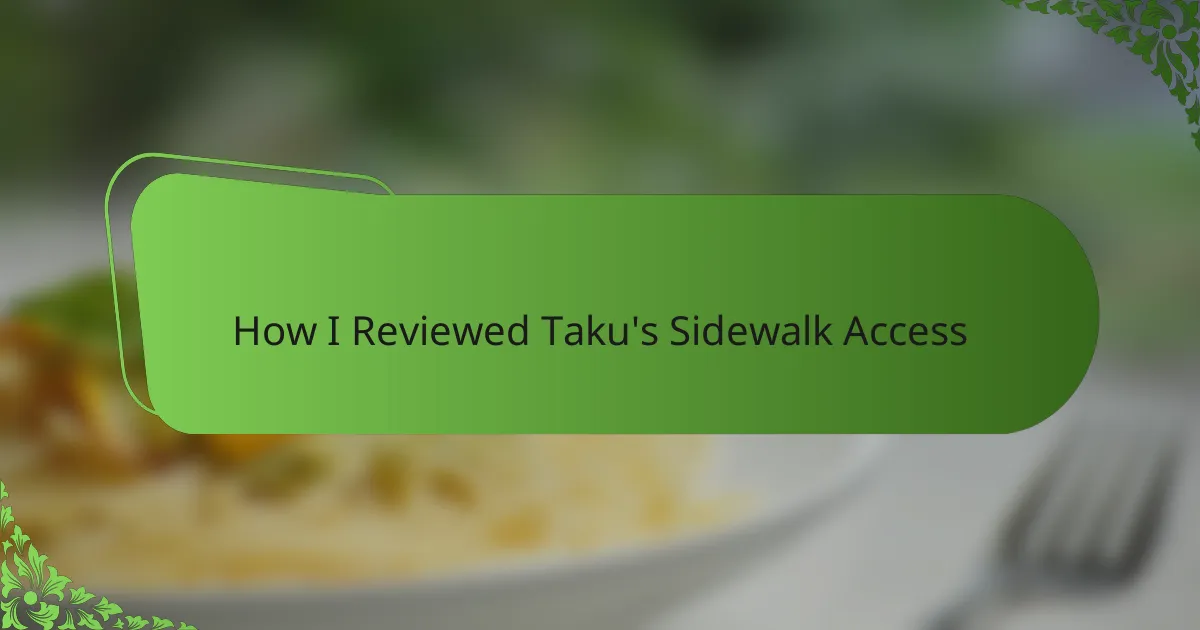Key takeaways
- Restaurant reviews provide insights beyond food, focusing on service quality and overall ambiance.
- Accessibility features, including parkability and entrance design, significantly impact the dining experience.
- Researching firsthand accounts and directly contacting restaurants can clarify accessibility details.
- A welcoming atmosphere and attentive service enhance the overall experience at restaurants like Sushi Nakazawa.

Understanding Sushi Restaurant Reviews
When I first started reading sushi restaurant reviews, I realized they’re more than just ratings—they capture the vibe and experience of a place. Have you ever felt overwhelmed by opinions that don’t quite match your taste? That’s why understanding the nuances in these reviews matters; they tell you what to expect beyond just the food.
I often look for details about service quality and accessibility since these aspects shape my visit just as much as the sushi itself. Reviews mentioning ease of parking or entry make a huge difference in planning my trip. Don’t you agree that feeling comfortable can turn a good meal into a memorable one?
Sometimes, reviewers share emotional stories about their experiences, which I find incredibly valuable. It helps me connect with the restaurant on a personal level and anticipate whether I’d enjoy the ambiance or not. Isn’t dining out as much about atmosphere as it is about taste?

Key Accessibility Factors for Sushi Spots
Accessibility at sushi spots goes beyond just wheelchair ramps. For me, it’s about how easily I can find parking nearby or whether the entrance feels welcoming without any physical obstacles. Have you ever been excited about a restaurant only to be stumped by a tricky front door or a staircase? Those moments can really dampen the anticipation.
Inside, I notice if the seating arrangements leave enough room to move comfortably or if the sushi bar layout makes it easy to chat with the chef. It’s little things like these that transform a meal from “just good” to truly enjoyable. I bet you’ve experienced a dinner where tight spaces made you feel cramped instead of relaxed.
Another important detail is how clearly the staff communicate about any accessibility features or potential challenges. When someone takes the time to explain what to expect, it makes me feel cared for and confident in my choice. Don’t you think that kind of attentiveness says a lot about the overall hospitality?

Research Methods for Restaurant Accessibility
When researching restaurant accessibility, I start by scouring official websites and user-generated reviews to spot any mentions of features like ramps, elevators, or accessible restrooms. Have you ever been frustrated by conflicting info online? That’s why cross-referencing multiple sources feels essential to me—it builds a clearer picture.
I also rely heavily on firsthand accounts from diners who share their detailed experiences navigating the space. Their stories often reveal subtle barriers or conveniences that official specs miss. For example, one review once described a door too heavy to open solo, which instantly shaped my expectations and planning.
Finally, I don’t hesitate to reach out directly to the restaurant with specific questions about accessibility. Calling or emailing shows me how willing the staff are to accommodate different needs, and it sometimes uncovers valuable tips you won’t find anywhere else. Hasn’t a quick conversation ever saved you from an unexpected hassle?

Evaluating Sushi Nakazawa’s Location
Finding Sushi Nakazawa’s location was a bit of a journey, but what struck me first was how conveniently it sits in a lively neighborhood with plenty of transit options. Have you ever stumbled upon a place only to realize public transport drops you right at the door? That kind of ease definitely boosted my excitement before even stepping inside.
Parking, often an afterthought for me, turned out surprisingly manageable here. I recall feeling relieved when I found a nearby garage without lengthy walks or confusing directions, which made getting to the restaurant feel stress-free—a crucial factor when you’re anticipating a special meal.
Walking up to Sushi Nakazawa, I noticed the entrance was discreet but inviting, without any tricky steps to worry about. It made me wonder: how often do we overlook these small but meaningful details that quietly set the tone for the dining experience? For me, this blend of accessibility and ambiance was a promising sign from the start.

Personal Experience at Sushi Nakazawa
Stepping inside Sushi Nakazawa, I immediately felt a sense of calm despite the busy street outside. The staff greeted me warmly and were quick to explain the seating arrangements, which made navigating the space feel effortless. Have you ever noticed how a thoughtful welcome can ease any lingering travel stress before a meal? That moment set the tone for the entire evening.
As I settled into the sushi bar, the layout allowed for comfortable movement and easy conversation with the chef. It reminded me how much I appreciate when a restaurant’s design encourages connection rather than feeling cramped or rushed. Have you ever left a place wishing you had more room to relax and enjoy the experience? This definitely wasn’t one of those times.
What stood out most was how attentive the team was throughout the meal without being intrusive. Their genuine care made me feel not just like a customer, but a valued guest. Doesn’t that kind of hospitality linger long after the last bite? For me, it turned Sushi Nakazawa into more than just a sushi spot—it became a memorable experience.

Practical Tips for Accessing Sushi Nakazawa
One tip that worked well for me was to plan my arrival outside of rush hour. Sushi Nakazawa’s neighborhood buzzes with activity, and I found that going early helped me avoid the crowd scramble for parking and made the walk in much smoother. Don’t you think timing can change the whole vibe of getting to a restaurant?
When I got there, I appreciated that the entrance had a gentle ramp, which felt thoughtful and practical—no awkward steps or heavy doors slowing me down. It’s such a relief when accessibility isn’t an afterthought but part of the design, right?
If you’re unsure about anything, I highly recommend calling ahead. The staff at Sushi Nakazawa were genuinely helpful when I asked about seating options and how to get in with a stroller. That little bit of communication gave me peace of mind that I’d be welcomed without surprises. Have you ever found a quick phone call saves you so much stress before a visit?



